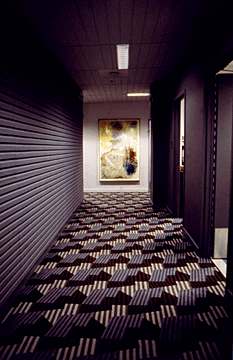 Once dismissed as visual "Musak," the use of
art in the workplace has come of age. Whether the business buys art to
brighten up its offices or begins to collect it in a big way, the fact is
that more corporations are purchasing art works today than ever before. In
fact, all this corporate art investment has prompted some people to call
U.S. businesses the new Medicis. Once dismissed as visual "Musak," the use of
art in the workplace has come of age. Whether the business buys art to
brighten up its offices or begins to collect it in a big way, the fact is
that more corporations are purchasing art works today than ever before. In
fact, all this corporate art investment has prompted some people to call
U.S. businesses the new Medicis.
According to the non-profit Business Committee on the
Arts, over 800 corporations nationwide have collections of art works. Most
find that it boosts employee morale, improves their public image, and, most
importantly, impresses clients.
As more and more firms become concerned enough about their
"image," more walls are becoming art-laden and executives and
their employees are becoming aware of how art affects their psyches and the
business. No longer just a "frill," art is now viewed as a
necessary component to modern office design.
The increase in modernistic office buildings also has
stimulated corporate art collecting. "A lot of corporations have found
that because of the massive scale of some of these new steel and glass
headquarters, they have to add something to bring the environment back to
the human level," notes Terry DeFazio, an associate of Newman Galleries
of Philadelphia. "For many companies, art is used to repersonalize the
environment."
The trend seems to be towards traditional scenes--barns,
country landscapes, boat scenes. "CEO's I have worked with want to
bring tranquility and fresh air inside through art," says Debbie Dittus
of In Prints of Paoli, a Philadelphia suburb. "I approach every
executive as an individual. Each has a certain stature to maintain in the
business community and likes to make art decisions slowly."
"The CEO's that have come into my shop are very staid
and want only thirties-style boat scenes and older landscapes," adds
Dittus. "I work with each corporation and often go to the office,
itself, to inspect the environment before making any consultations on what
art should be purchased. After making the survey, I bring back a selection
of art works to the office so that the executives can make up their minds in
their own environment."
There is a definite difference between art work placed on
the walls of an executive office and that placed on the walls of general
workplaces. While the head office might have original oil paintings, a
medium that seems to show status in the business community, the general
workplace might have quality lithographs of traditional scenes.
"Executives care not only that their office contains
the prescribed number of paintings, but also that the art conveys an image
or mood," says DeFazio. "Some executives even select pieces that
enhance the business atmosphere, such as old hand-colored hunt
engravings."
All the new offices in the region have been a boon to
galleries and to some extent artists. Many buy paintings of well-known local
or regional artists whose works are easily recognizable. This links a
business to it community and the people who make up the firm's client base.
Many in the art world say corporate collecting is
expanding the audience for art, as more people see it every day. DeFazio
feels that corporations are no longer talking down to their employees
through their art. Instead, she has noticed a trend in purchases of old
masters' prints rather than generic country scenes.
Dittus, who along with her partner, Shirley Feinberg, has
a background in interior design, says, "If the colors of the art work
complement the environment, then everyone feels at home with it."
|
